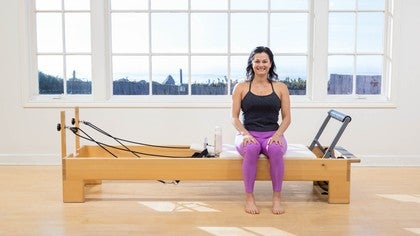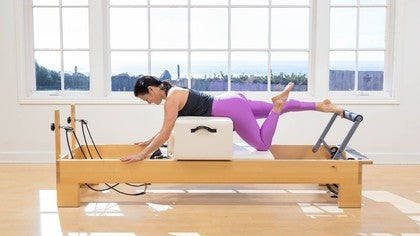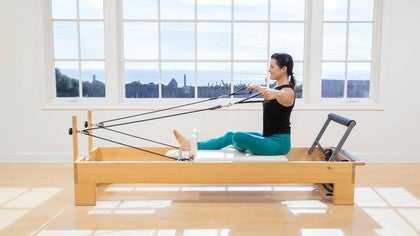Description
About This Video
Transcript
Read Full Transcript
Thank you for joining me. My intention with this tutorial is to offer you some tips to tune in to work on understanding how to use your body a little bit differently, or perhaps help iron out some kinks or sticky spots that you may have. Really, what I'm doing here is sharing what I do. If you were to peer into my Pilates studio and see me work out on a regular basis, you'll see me use some of these tips to help fix and tune up my body so that when I go out and do things and don't have time to think about it, it shows up better. So let's talk.
First, breath. Breath is so important. And we talk a lot about breath in Pilates. Traditionally, the breath is in through the nose and out through the mouth. But oftentimes, in through the nose and out through the nose is going to be a little bit better choice.
And I'm going to encourage you to play with that breath sometimes. Perhaps all the time, if that suits you. The inhale, the nasal breathing in and out helps to calm the nervous system and is actually the way that we were truly meant to breathe on a regular basis. Using the mouth to exhale sometimes is okay. And certainly when you're talking, it's necessary, but I'm going to encourage you to change it up and play with that a little bit.
So let's just talk a little bit about a sitting posture here, and then we'll focus in on the breath. If you see me sitting when I'm teaching, oftentimes you'll see me wobbling around and being mobile because I'm trying to find my bony landmarks. So I'm gonna explain that to you now. I'm sitting on both sitz bones. I'm actually not even trying hard to use my belly, so you may see my tissue hanging out and relaxed, and I'm looking for that feeling.
We often ask people to scoop the flesh out from underneath their hip bones, but I want you to take it a step further, and I want you to think of scooping the flesh to the side as well. Scoop your hand underneath your sitz bone and see if you can pull that tissue to the side there. And then underneath the other sitz bones, and pull the tissue to the side, and then see if you can find a rest point with your legs so that you can sit more equally on all three points of your pelvis like this. So you have some connection with the pubic bone, as well as both sitz bones. So sit with that for a moment and find your rest point.
Find ease here. Sense that your feet are soft. Sense that your ribcage is sitting on top of your pelvis and your head on top of your ribcage. And then just let your hands rest wherever it's comfortable for you. Close your eyes, and breathe.
I want you to think about inhaling through your nose, long and deep, and exhaling through your nose even longer. Really calming that breath and allowing it to be soft and gentle. And then I want you to enjoy that breathing as you think about your diaphragm. When you inhale, your diaphragm actually contracts and lowers. I like to think about my diaphragm caressing the front of my spine all the way down to my tailbone.
With the exhale, it floats up. And I like to think about it floating all the way up and softening my throat, helping me lengthen. Think about that, inhale down in the direction of your pelvis, and with the exhale up, in the direction of your throat. So I encourage you to play with that breathing, feel the diaphragm breathing, and then take it a step further and be okay with letting the belly soften and be okay with... Well, ultimately we are trying to breathe into those ribs and get that lateral posterior breathing, but be okay with the belly softening to help you find that sometimes, okay?
So for the next pieces, the next few pieces, I'm going to lie down. You can use a reformer, or you can just lie flat on your back to try these, or you can also just watch me and then try it later. So here we go. I'm gonna lie down on my reformer, and I'm just flat. That's my plan here is just to lie flat and settle in and be kind of comfortable here.
So what does settle in mean? I want you to spend just a couple of moments feeling your pelvis position. So that you can see better, I'm just gonna let my legs hang over the reformer. You're welcome to do that as well. Feel your pelvis here and put your fingers on your pubic bone and the heels of your hands on your hip bones, and just kind of play around a little bit with where your pelvis is, down, up, side, side, circle around.
Notice if you have any kinks and see if you can kind of iron out the kink by moving a little bit through that area. Remember that any movement you do should be done without pain. It should be done with ease and grace and you should have wiggle room in any position that you're in, so it should feel pretty easy to do that. If it doesn't, then don't move as much. I'm gonna put my feet back on the bar, just so I can feel this position.
And then I'm gonna bring my attention to my hip creases. So what I want you to do, with these knees bent, you wanna stick your fingers just underneath the hip bone or just that's the ASIS there, in between the hip bone and the hip crease, and feel that that should be kind of juicy and soft there. If you're super grippy there and your tissue doesn't let you in there, you wanna work on finding that ease point where it can be relaxed. So perhaps your foot bar is too close to you, or you'll move your feet just a little bit away from you on the floor. That's one thing to think about.
Now, I want you to take your fingers and just take a little bit of a journey, if you will, a little walk around your bony landmarks and notice if you feel any sticky points. I'm doing literally just like a little, like a walk with my fingers. And when I feel sticky points, perhaps in my gut area, or up around my ASIS, I'll just kind of breathe into that for a few moments. Soften a few things, perhaps. Now, take your fingers up to your ribcage area.
Oftentimes, our ribs are not in a position that is ideal and ideal is a process, so don't be too hard on yourself and allow it to happen in your own time. Ultimately, we wanna have the upper spine resting on the mat with the ribcage actually open in the front and fanning restfully on the back, okay? So sometimes, there's stickiness and we try too hard from the center of the body here. And that actually stifles the ability to use certain muscles. So I'm gonna ask you to just relax here.
And take your fingers at the center of your ribcage, right by the xiphoid process and just do that same thing where you take a little walk with your fingers around your ribs, you palpate. If you feel a sticky spot or a place that makes you a little bit nauseous, perhaps keep your finger there for a moment and breathe. Spend more time doing this. Whenever it feels like you're having a hard time breathing, sometimes your diaphragm can get adhered to various different things and make it difficult to breathe fully. So enjoy that and play with it.
Now, taking your fingers up to your sternum. Once again, you can sort of soften the sternum a little bit, push downward a little bit to allow perhaps the ribs to ground a little bit better, but then also feel how there's like an opening across the front of your throat and up through the back of your neck as well when you do that. Another place we have stickiness is the tissue around the chest. So I'm going to encourage you from your sternum to do that same little walk. You can do one at a time, or you can actually do both at the same time and take a little walk.
If you feel a sticky point, you're just gonna give a little bit of attention there. I'm not really massaging, I'm just kind of waking up. Go around all the way around the pec tissue, all the way around the breast tissue, if you're a woman. Come around to the side here. And you can actually use perhaps your other hand to get up into the area more near the shoulder here, underneath the collar bone, as well.
And you should do the whole area and then start to pay attention to where you habitually are tight or notice if it's moving around. For many of us, it moves. So we've settled the head, we've settled the chest. We've settled the pelvis. Now, a lot of us are a little bit sticky in that quad region and we use the upper hip crease a little bit too much when doing various different leg movements.
So remember, if you can get your hands to kind of wedge into that hip bone area, hip crease area just underneath the ASIS, when you initiate the push-out on the reformer, your tissue shouldn't push you out. So you wanna make sure that as you initiate, you can keep that softness through the hip. And if you're unable to do that, you might work on really trying to just sit here long enough to wake up the back of the leg. Now, as you extend the legs out to straight, you wanna also feel there's this opening across the front of the hips, so I'll call this the finger sweep, where I'll use my fingers to just create a little bit of an open sensation across the front of the hips. Coming in, again, you might take your hands on that hip crease and feel that it's soft.
Now, if you're unable to soften here, you'll use perhaps this pressing sensation. So I'll take the heels of my hands and I'll push into my thighs pretty powerfully. And then I bring myself just a little bit off the stopper with that. And I'm using my hands to kind of push also my thigh bones in. I'm rolling my tissue in a little bit.
That creates a really beautiful openness in my back, in my pelvis, and then also allows me to soften the tissue across the front of the hip crease there, and wake up the back. So maybe you'll pulse a little bit here. Or maybe you'll use that tactic as you come in sometimes to try to wake up the back of the leg a little bit more powerfully. That same tool can be used when you're in external rotation. Also, when you're in your hip work, you can use that tool with your feet in straps.
So if I were to go to a wide V position, I might put my hands on my thighs and I'm gonna push, the intention is to rotate out a little bit more. So I braced my elbows down and I can just sit with this and kind of feel where the sticky points are and try to release. So what I currently feel right now is tightness across my inside inner thigh on my left and a little bit here in my hip crease, so I'm just kind of ironing that out for a moment. Go back to both of them. And then come on in.
And a final tool is actually using your hands to help stretch and maneuver your tissue a little bit. I use this one a lot. I'm just going to put my feet back on the bar, comfortably press out. And oftentimes, I'm sticky on my left hip. I don't fully extend, and it's hard for me to find my way.
So I'm gonna use my one hand. I'm gonna show you on the right, so you can see. My one hand on my belly tissue, and I'm gonna grab some skin, some tissue, and I'm gonna pull it over toward the belly button. And then I'm gonna use my other hand to create like a finger sweep to soften. And I feel a release here.
It's really quite nice. I will say, I'm gonna show the other side just because that's where I need it. I'm pulling my tissue and I'm finger sweeping here, or hand sweeping, just kind of getting a little bit of an open feeling. So you may find that you can get a good grip through your pants here, but I find that skin to skin is a little bit easier, so you may explore doing this with your fingers on your bare skin, so you can get a little bit more opening sensation there. Gently come on in.
And I'm gonna make my way up to a sitting position. And settle in, once again, with that beautiful open pelvis position. And let's just settle in again with our breath, just be here for a moment, and return to that idea of inhaling and exhaling. Fill your head, fill your ribcage. Inhaling through your nose, exhaling through your nose.
And I certainly hope that these tips help you work a little bit deeper, a little bit differently and iron out some kinks in your Pilates practice. Thank you so much for playing.





You need to be a subscriber to post a comment.
Please Log In or Create an Account to start your free trial.